六年级英语第七模块教案 (1)
- 格式:doc
- 大小:62.50 KB
- 文档页数:14
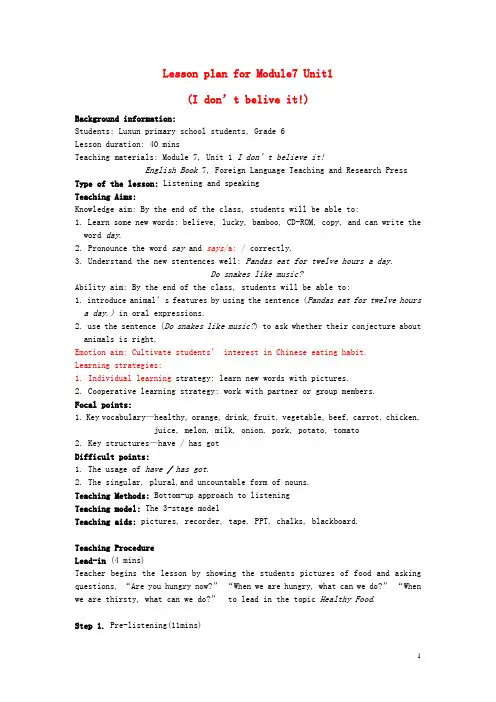
Lesson plan for Module7 Unit1(I don’t belive it!)Background information:Students: Luxun primary school students, Grade 6Lesson duration: 40 minsTeaching materials: Module 7, Unit1 I don’t believe it!English Book 7, Foreign Language Teaching and Research Press Type of the lesson: Listening and speakingTeaching Aims:Knowledge aim: By the end of the class, students will be able to:1. Learn some new words: believe, lucky, bamboo, CD-ROM, copy, and can write the word day.2. Pronounce the word say and says/a: / correctly.3. Understand the new stentences well: Pandas eat for twelve hours a day.Do snakes like music?Ability aim: By the end of the class, students will be able to:1. introduce animal’s features by using the sentence (Pandas eat for twelve hoursa day.) in oral expressions.2. use the sentence (Do snakes like music?) to ask whether their conjecture about animals is right.Emotion aim: Cultivate students’ interest in Chinese eating habit.Learning strategies:1. Individual learning strategy: learn new words with pictures.2. Cooperative learning strategy: work with partner or group members.Focal points:1. Key vocabulary—healthy, orange, drink, fruit, vegetable, beef, carrot, chicken,juice, melon, milk, onion, pork, potato, tomato2. Key structures—have / has gotDifficult points:1. The usage of have / has got.2. The singular, plural,and uncountable form of nouns.Teaching Methods: Bottom-up approach to listeningTeaching model: The 3-stage modelTeaching aids: pictures, recorder, tape, PPT, chalks, blackboard.Teaching ProcedureLead-in(4 mins)Teacher begins the lesson by showing the students pictures of food and asking questions, “Are you hungry now?” “When we are hungry, what can we do?” “When w e are thirsty, what can we do?” to lead in the topic Healthy Food.Step 1. Pre-listening(11mins)1. Write the words food and drink on the blackboard.2. Ask a student “What did you eat yesterday?” in order to classify the food into3 kinds, fruit, vegetable and meat. Blackboard layout as follow,3.Ask students “What’ the food?” students may repeat“Fruit, vegetables andmeat are food.”4. Ask students “What fruit/ vegetables/ meat/ drink do you know?”, and writetheir answers on the blackboard. When talk about juice, explain the expressions of different kinds of juice.(e.g. apple juice)5. Ask students to open their book and finish the three activities(Activity 1,2, 3) individually. Then call back the answers from the whole class as complete sentences.(e.g. Picture 1 is fruit, and in picture 1 there is an apple, a melon and an orange.)Activity 1 Work in pairs. Match the words with the pictures.Answersfood: 1;2;3 drink:4Activity 2 Label the food in the pictures with these words.Answersfruit:1 meat:3 vegetables:2Activity 3 Label the food and drink with these words.Answersa. melonb. applec. oranged. chickene. porkf. beefg. tomato h. potato i. carrot j. onion k. water l. milk m. Juice6. Explain and show the singular, plural, and uncountable form of nouns. Then askstudents to write the plural form near the words on P26, Ativity 1, and then askstudents to read the words on PPT.Step II. While-listening(15mins)1. Do Activity 4①. Teacher ask “Do you know Betty? What Betty and her mother have got?” then play the recording and ask students to focus on the shopping list.②. Play the recording again for them to check. Call back the answers from the wholeclass.③. Ask students work in pairs and make dialogue.(e.g. A: Have they got any apples?B: Yes, they have.)Answersoranges√ beef × onions × apples√ pork carrotsmelons× tomatoes√ milk chicken√ potatoes√ juice2. Do Activity 6①. Ask students to read the four sentences in Activity 6 silently, then one studentto read loudly.②. Play the recording for the students.③. Call back the answers from the whole class.Answers1. juice2. meat3. Yes, they have.4. No, they haven’t.④.Play the conversation again and pause after each phrase, point out the grammarpoint.⑤. Ask students to read these dialogues after the tape individually, and thenputthem into groups of four to practice the dialogue.Step III. Post-listening1.Do Activity 7(10mins)①Play the recording once without stopping.②Play the recording again and stop at the end of each line. Ask the whole classto repeat.③Ask students to practice in pairs.2.Do Activity 8. Choose six words in Activity 4. Work in pairs and makedialogues.①Ask students to choose six words secretly and not tell anyone.②Read the example with the class. Then pair them to make dialogues..③Ask some pairs of them to present the dialogues.Homework: Practice the conversation in Activity 5 and sounds in Activity 7.Blackboard Layout: key words and sentences。
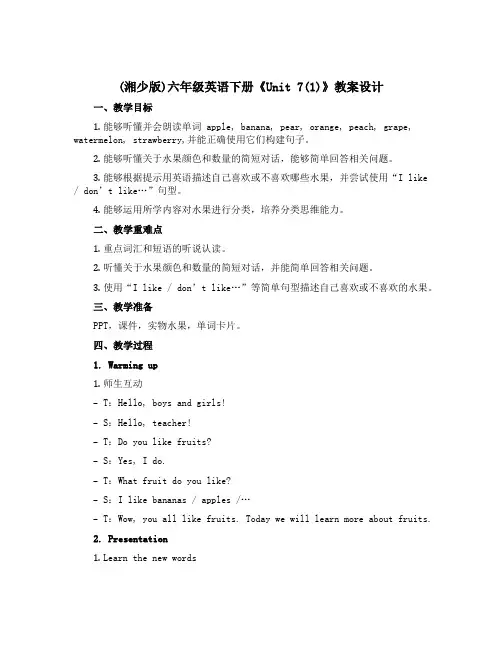
(湘少版)六年级英语下册《Unit 7(1)》教案设计一、教学目标1.能够听懂并会朗读单词 apple, banana, pear, orange, peach, grape, watermelon, strawberry,并能正确使用它们构建句子。
2.能够听懂关于水果颜色和数量的简短对话,能够简单回答相关问题。
3.能够根据提示用英语描述自己喜欢或不喜欢哪些水果,并尝试使用“I like / don’t like…”句型。
4.能够运用所学内容对水果进行分类,培养分类思维能力。
二、教学重难点1.重点词汇和短语的听说认读。
2.听懂关于水果颜色和数量的简短对话,并能简单回答相关问题。
3.使用“I like / don’t like…”等简单句型描述自己喜欢或不喜欢的水果。
三、教学准备PPT,课件,实物水果,单词卡片。
四、教学过程1. Warming up1.师生互动–T:Hello, boys and girls!–S:Hello, teacher!–T:Do you like fruits?–S:Yes, I do.–T:What fruit do you like?–S:I like bananas / apples /…–T:Wow, you all like fruits. Today we will learn more about fruits.2. Presentation1.Learn the new words–apple /banana / pear / orange / peach / grape / watermelon / strawberry–让学生跟读并认读。
2.Listen and match–让学生听音频,将图片和单词匹配。
–再放一遍让学生检查自己的答案。
3.Look and say–让学生看图片,学习表达颜色和数量。
•T:How many apples do you see?•S:I see two apples.–让学生模仿老师读句子。
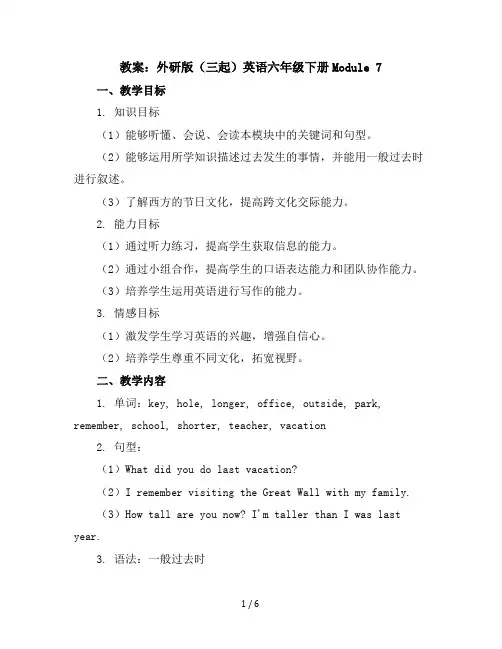
教案:外研版(三起)英语六年级下册Module 7一、教学目标1. 知识目标(1)能够听懂、会说、会读本模块中的关键词和句型。
(2)能够运用所学知识描述过去发生的事情,并能用一般过去时进行叙述。
(3)了解西方的节日文化,提高跨文化交际能力。
2. 能力目标(1)通过听力练习,提高学生获取信息的能力。
(2)通过小组合作,提高学生的口语表达能力和团队协作能力。
(3)培养学生运用英语进行写作的能力。
3. 情感目标(1)激发学生学习英语的兴趣,增强自信心。
(2)培养学生尊重不同文化,拓宽视野。
二、教学内容1. 单词:key, hole, longer, office, outside, park, remember, school, shorter, teacher, vacation2. 句型:(1)What did you do last vacation?(2)I remember visiting the Great Wall with my family.(3)How tall are you now? I'm taller than I was last year.3. 语法:一般过去时4. 功能句:What did you do yesterday? I stayed at home yesterday.三、教学重点与难点1. 重点:单词的准确拼读和意义,句型的运用。
2. 难点:一般过去时的运用,描述过去发生的事情。
四、教具与学具准备1. 教具:多媒体课件、录音机、磁带。
2. 学具:课本、练习册、单词卡片。
五、教学过程1. 热身(5分钟)(1)教师与学生用Hello, good morning等问候语进行互动。
(2)引导学生回顾上一模块学过的内容,为新课的学习做好铺垫。
2. 引入(10分钟)(1)教师通过提问方式引导学生思考过去的事情,如:"Whatdid you do last week?"。
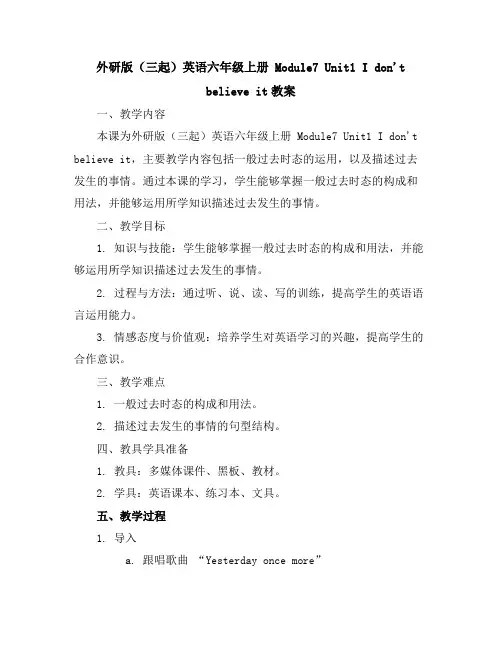
外研版(三起)英语六年级上册 Module7 Unit1 I don'tbelieve it教案一、教学内容本课为外研版(三起)英语六年级上册 Module7 Unit1 I don't believe it,主要教学内容包括一般过去时态的运用,以及描述过去发生的事情。
通过本课的学习,学生能够掌握一般过去时态的构成和用法,并能够运用所学知识描述过去发生的事情。
二、教学目标1. 知识与技能:学生能够掌握一般过去时态的构成和用法,并能够运用所学知识描述过去发生的事情。
2. 过程与方法:通过听、说、读、写的训练,提高学生的英语语言运用能力。
3. 情感态度与价值观:培养学生对英语学习的兴趣,提高学生的合作意识。
三、教学难点1. 一般过去时态的构成和用法。
2. 描述过去发生的事情的句型结构。
四、教具学具准备1. 教具:多媒体课件、黑板、教材。
2. 学具:英语课本、练习本、文具。
五、教学过程1. 导入a. 跟唱歌曲“Yesterday once more”b. 老师出示一张图片,描述图中发生的事情,引导学生关注过去时态。
2. 新课展示a. 老师创设情境,展示本课的主要句型。
b. 学生跟读并模仿句型。
3. 趣味练习a. 学生两人一组,用一般过去时态描述过去的事情。
b. 老师邀请几组学生上台展示,并给予评价。
4. 巩固提高a. 老师出示一些图片,学生用一般过去时态描述图片中的事情。
b. 学生互相交换练习,互相评价。
5. 课堂小结b. 学生分享学习收获。
六、板书设计1. 课程外研版(三起)英语六年级上册 Module7 Unit1 I don't believe it2. 重点句型:一般过去时态的构成和用法,描述过去发生的事情的句型结构。
3. 课堂活动安排:导入、新课展示、趣味练习、巩固提高、课堂小结。
七、作业设计1. 听力练习:听懂并能够复述本课的对话内容。
2. 口语练习:用一般过去时态描述过去的事情,不少于5句话。
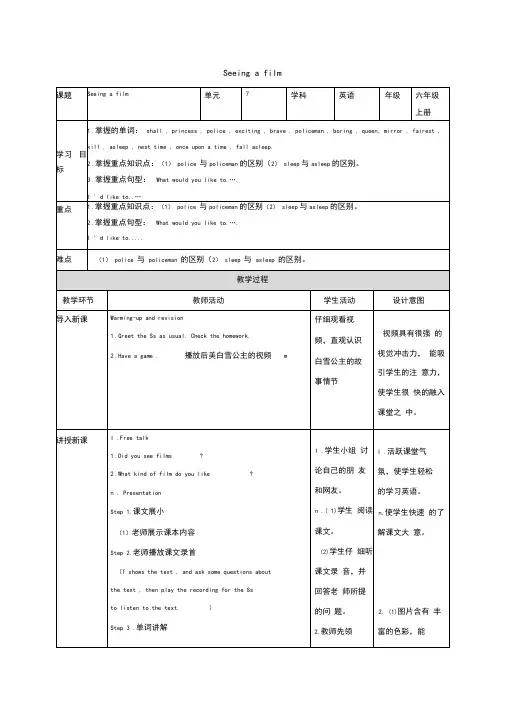
Seeing a film例如:(1) The police caught the robber.警方抓到了强盗。
(2) The police are bright and brave.警察又聪明又勇敢。
policemanpoliceman是可数名词。
复数形式是policemen , 说“一个警察"通常用"a policeman ”。
例如:(1)他的爸爸是一个警察。
His father is a policeman.(2)他们是警察。
They are policemen.(2) sleepsleep :动词或名词,“睡觉,睡眠”例如:(1)他昨晚睡的很好。
He slept well last night.(2)不要在课堂上睡觉。
Don't sleep in class.asleep 的用法asleep :形容词,“睡着的”,表示状态。
它不能用very修饰,只可用much, fast等词修饰。
例如:(1)When he came home last night ,we were asleep. 他昨晚回家时,我们都睡着了。
(2)She was asleep in class.她在课堂上睡着了。
Story ?S2: What is it about ?S1: It is an interesting story about a brave policeman. S2: OK.Shall we see it at 11:00a.m.Step 5重点句型 Shall we 根据图片,情景对话。
CHy CIceEgSnuw WhiteBO rnriurissIt is an interesting story about □ beautiful princess.BE k an rndting £t6fy about a brave policemanuSynny CinemaHi# Monkey Ku<g iiQm1小小1 dm 31 10 Q frt. S J 20 pjm 7:2Q p.m.]t is □ story about a的熟练程度。
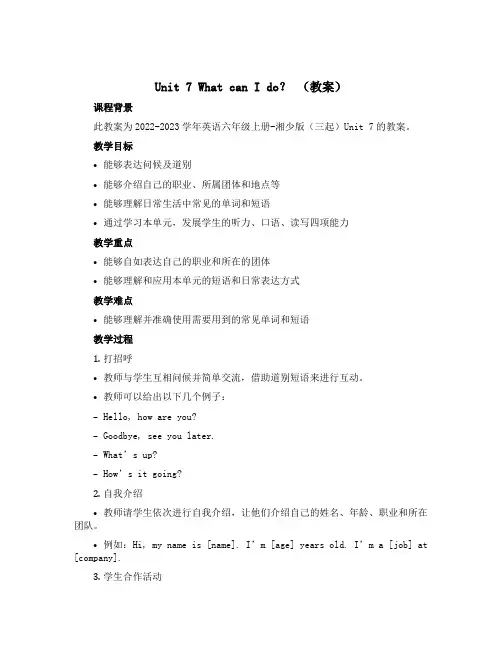
Unit 7 What can I do?(教案)课程背景此教案为2022-2023学年英语六年级上册-湘少版(三起)Unit 7的教案。
教学目标•能够表达问候及道别•能够介绍自己的职业、所属团体和地点等•能够理解日常生活中常见的单词和短语•通过学习本单元,发展学生的听力、口语、读写四项能力教学重点•能够自如表达自己的职业和所在的团体•能够理解和应用本单元的短语和日常表达方式教学难点•能够理解并准确使用需要用到的常见单词和短语教学过程1.打招呼•教师与学生互相问候并简单交流,借助道别短语来进行互动。
•教师可以给出以下几个例子:–Hello, how are you?–Goodbye, see you later.–What’s up?–How’s it going?2.自我介绍•教师请学生依次进行自我介绍,让他们介绍自己的姓名、年龄、职业和所在团队。
•例如:Hi, my name is [name]. I’m [age] years old. I’m a [job] at [company].3.学生合作活动•教师将学生分成小组,让他们相互交流,并询问队友的职业和所在团队等信息。
鼓励学生使用本单元的词汇和短语。
•在小组讨论完毕后,各小组成员可以分享他们了解到的信息。
4.视听材料•教师播放与本单元相关的视听材料,包括单词、短语、会话和歌曲等。
•学生缓慢地跟着播放中的材料念读单词,学习短语并模仿会话。
5.短语练习•教师可以在白板上呈现本单元的短语,要求学生跟读,默念,并检查学生的发音和语调。
•例如:What can I do for you? / Where are you from? / How old are you? / I’m in class now. / Thank you very much. / You’re welcome.6.课堂练习•教师在课程末尾进行课堂练习,包括听力、口语、阅读和写作等各个方面。
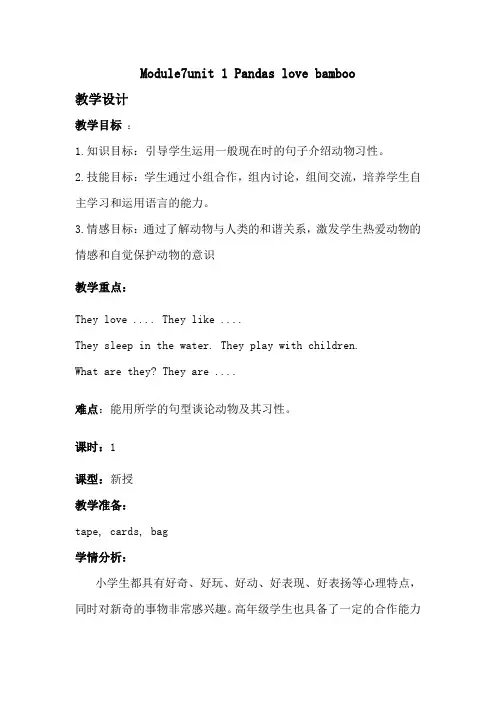
Module7unit 1 Pandas love bamboo教学设计教学目标:1.知识目标:引导学生运用一般现在时的句子介绍动物习性。
2.技能目标:学生通过小组合作,组内讨论,组间交流,培养学生自主学习和运用语言的能力。
3.情感目标:通过了解动物与人类的和谐关系,激发学生热爱动物的情感和自觉保护动物的意识教学重点:They love .... They like ....They sleep in the water. They play with children.What are they? They are ....难点:能用所学的句型谈论动物及其习性。
课时:1课型:新授教学准备:tape, cards, bag学情分析:小学生都具有好奇、好玩、好动、好表现、好表扬等心理特点,同时对新奇的事物非常感兴趣。
高年级学生也具备了一定的合作能力和参与意识,在一定的情境中,学生能够积极的参与、大胆表达、勇于合作,展现出良好的学习氛围。
教教学设计Step1: Warmer1.Greetings.2.Sing a song “Old MacDonald has a zoo.”3.引出动物猴子、猫、大象、熊猫进行复习.T: Cats, dogs, pandas lions, we call them animals. Do you like animals?What's your favourite animal? (课件展示动物园里各种动物,让学生变用英语说出自己最喜欢的动物)Ss: ...T: My favourite animal is panda. Tell me more about pandas?What do pandaslike to eat? Yes, they like bamboo. Sometimes they eat fish, fruits,vegetables. But we know pandas like to eat bamboo. Pandas love bamboo.Today we are going to learn Module 7 Unit 2 Pandas love bamboo.引出本课课题并板书课题。
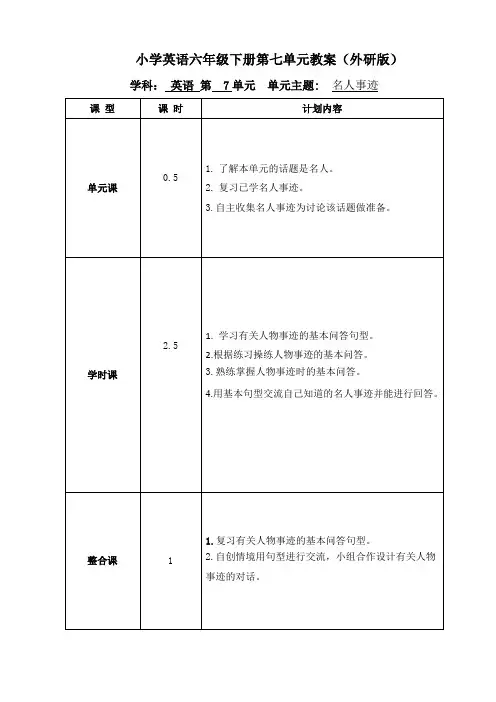
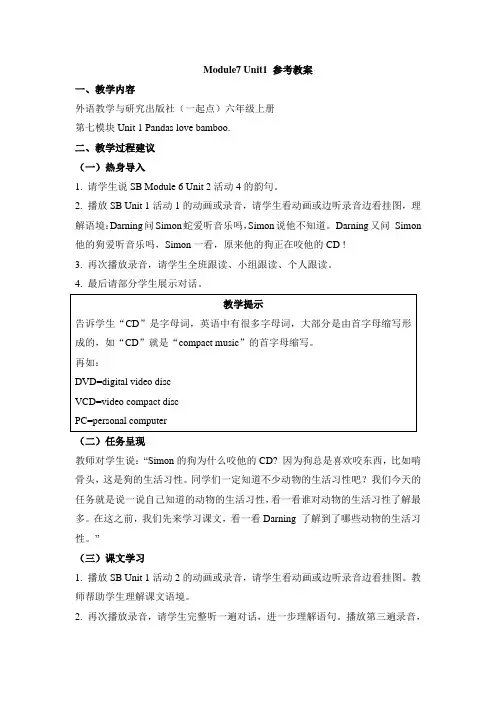
Module7 Unit1 参考教案一、教学内容外语教学与研究出版社(一起点)六年级上册第七模块Unit 1 Pandas love bamboo.二、教学过程建议(一)热身导入1. 请学生说SB Module 6 Unit 2活动4的韵句。
2. 播放SB Unit 1活动1的动画或录音,请学生看动画或边听录音边看挂图,理解语境:Darning问Simon蛇爱听音乐吗,Simon说他不知道。
Darning又问Simon 他的狗爱听音乐吗,Simon一看,原来他的狗正在咬他的CD !3. 再次播放录音,请学生全班跟读、小组跟读、个人跟读。
4. 最后请部分学生展示对话。
(二)任务呈现教师对学生说:“Simon的狗为什么咬他的CD? 因为狗总是喜欢咬东西,比如啃骨头,这是狗的生活习性。
同学们一定知道不少动物的生活习性吧?我们今天的任务就是说一说自己知道的动物的生活习性,看一看谁对动物的生活习性了解最多。
在这之前,我们先来学习课文,看一看Darning 了解到了哪些动物的生活习性。
”(三)课文学习1. 播放SB Unit 1活动2的动画或录音,请学生看动画或边听录音边看挂图。
教师帮助学生理解课文语境。
2. 再次播放录音,请学生完整听一遍对话,进一步理解语句。
播放第三遍录音,请学生逐句跟读。
对于学生跟读有困难的语句,教师先带读较难词语,然后按照意群、节奏重点带读,请学生注意模仿语音语调。
3. 在跟读过程中,通过展示图片、做动作、说明等方式,学习“bamboo, gave, its, almost, deaf, frightened” 的语义,并对“gave, its” 进行运用训练。
4. 请学生观察、分析、归纳对话中的行为动词一般现在时的特点及基本用法,并适当扩展到其他人称。
5. 完成AB Unit 1练习1。
这是课文阅读理解练习。
教师引导学生理解练习要求:根据课文内容和答句,写出问句。
先请部分学生朗读答句,再请全体学生完整地阅读一遍课文,根据课文内容和横线下方的答句,在横线上写出相应问句。
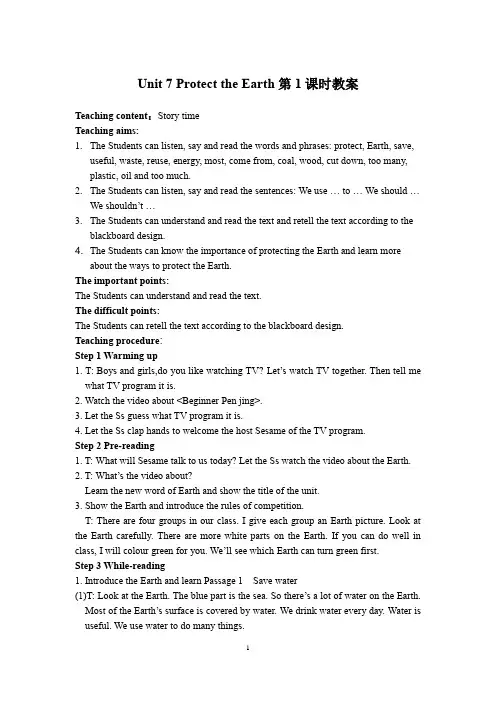
Unit 7 Protect the Earth第1课时教案Teaching content:Story timeTeaching aims:1.The Students can listen, say and read the words and phrases: protect, Earth, save,useful, waste, reuse, energy, most, come from, coal, wood, cut down, too many, plastic, oil and too much.2.The Students can listen, say and read the sentences: We use … to … We should …We shouldn’t …3.The Students can understand and read the text and retell the text according to theblackboard design.4. The Students can know the importance of protecting the Earth and learn moreabout the ways to protect the Earth.The important points:The Students can understand and read the text.The difficult points:The Students can retell the text according to the blackboard design.Teaching procedure:Step 1 Warming up1. T: Boys and girls,do you like watching TV? Let’s watch TV together. Then tell me what TV program it is.2. Watch the video about <Beginner Pen jing>.3. Let the Ss guess what TV program it is.4. Let the Ss clap hands to welcome the host Sesame of the TV program.Step 2 Pre-reading1. T: What will Sesame talk to us today? Let the Ss watch the video about the Earth.2. T: What’s the video about?Learn the new word of Earth and show the title of the unit.3. Show the Earth and introduce the rules of competition.T: There are four groups in our class. I give each group an Earth picture. Look at the Earth carefully. There are more white parts on the Earth. If you can do well in class, I will colour green for you. We’ll see which Earth can turn green first.Step 3 While-reading1. Introduce the Earth and learn Passage 1 Save water(1)T: Look at the Earth. The blue part is the sea. So there’s a lot of water on the Earth. Most of the Earth’s surface is covered by water. We drink water every day. Water is useful. We use water to do many things.Learn: use, useful.(2)Complete the sentence: We use water to…(3)Talk about two pictures about wasting water first,then talk about two pictures of water scarcity.(4)Complete the sentences according to the four pictures: We should water. We should not water.(5)Scan the first passage of the text and answer Sesame’s question: How to save water? Learn : reuse(6) Look at the pictures and complete the sentence: We can reuse water to…(7)Read Passage 1 according to the reading symbols.2. Passage 2 Save energy(1)Listen and judge①Most of our energy comes from coal and oil.( )①There is much coal and oil on Earth.( )① We should drive every day.( )(2)Listen to Sesame to introduce the energy used in China.Sesame : 70% energy comes from coal. 18% energy comes from oil.(3)T: Where does other energy come from?S: It comes from…(4)The T introduces other energy: solar energy, wind energy, hydroenergy and nuclear energy.(5)T: Energy is very precious. The more we use, the less is left.(6)Sesame: What can we do to save energy?(7)Read Passage2 with emotion in the music.3.Passage 3 Save trees(1)Sesame: ①Why should we save trees?①How to save trees?Let the Ss read the passage silently and underline the answers(2) Show two pictures and the let the Ss choose the picture of of cutting down trees.(3)Listen and imitate.4. Passage 4 Don’t use too much plastic(1)T: Sesame will introduce his friend to us. Who’s his friend? Let the Ss Watch the cartoon about a plastic bag.(2)Who’s his friend? Learn the new word: plastic(3)T: Is plastic good or bad? Divide the Ss into two groups and let them have a debate.A: I think plastic is good. Because…B: I think plastic is bad. Because…(4)T: Plastic is good for us, but too much plastic is bad for the Earth. When we finishour drinks, please don’t throw them away, we can reuse them.(5)T: Sesame can reuse the plastic bottles to grow vegetables. Let the Ss enjoy some pictures about Sesame’s vegetable garden.(6)T: What do you think of Sesame’s vegetable garden?(7) Read Passage 4 together.5. Read the whole text together.6. T: How to protect the Earth?7. Retell the text in groups of four. One student retells one aspect.Step 4 Post-reading1.There are four kinds of picture books: save water, save energy, save trees and don’t use too much plastic.Let the Ss complete the sentences and make a picture book.2. Ask two Ss to share their picture books.3. T: The Earth is not only a planet, but also our home. We should protect the Earth.4. Let the Ss stand up and take an oath with Sesame.To protect the Earth, we should start from now,start from myself.5. T: Sesame arranges you three assignments.(1)Read the text and try to retell it.(2)Share your picture book with your family or classmates.(3)Use waste things to make something.6. Say goodbye to Sesame.Blackboard design:。
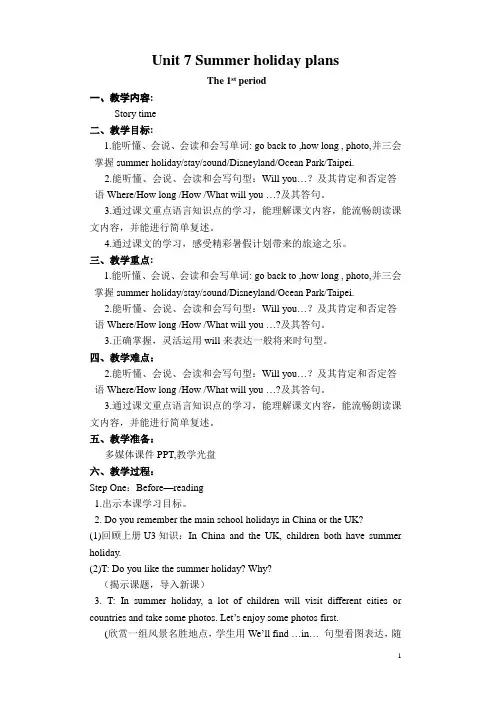
Unit 7 Summer holiday plansThe 1st period一、教学内容:Story time二、教学目标:1.能听懂、会说、会读和会写单词: go back to ,how long , photo,并三会掌握summer holiday/stay/sound/Disneyland/Ocean Park/Taipei.2.能听懂、会说、会读和会写句型:Will you…?及其肯定和否定答语Where/How long /How /What will you …?及其答句。
3.通过课文重点语言知识点的学习,能理解课文内容,能流畅朗读课文内容,并能进行简单复述。
4.通过课文的学习,感受精彩暑假计划带来的旅途之乐。
三、教学重点:1.能听懂、会说、会读和会写单词: go back to ,how long , photo,并三会掌握summer holiday/stay/sound/Disneyland/Ocean Park/Taipei.2.能听懂、会说、会读和会写句型:Will you…?及其肯定和否定答语Where/How long /How /What will you …?及其答句。
3.正确掌握,灵活运用will来表达一般将来时句型。
四、教学难点:2.能听懂、会说、会读和会写句型:Will you…?及其肯定和否定答语Where/How long /How /What will you …?及其答句。
3.通过课文重点语言知识点的学习,能理解课文内容,能流畅朗读课文内容,并能进行简单复述。
五、教学准备:多媒体课件PPT,教学光盘六、教学过程:Step One:Before—reading1.出示本课学习目标。
2. Do you remember the main school holidays in China or the UK?(1)回顾上册U3知识:In China and the UK, children both have summer holiday.(2)T: Do you like the summer holiday? Why?(揭示课题,导入新课)3. T: In summer holiday, a lot of children will visit different cities or countries and take some photos. Let’s enjoy some photos first.(欣赏一组风景名胜地点,学生用We’ll find …in…句型看图表达,随机教学Taipei)4. T:I’ll go to Hong Kong by plane this summer holiday. I’ll visit Ocean Park, Disneyland and Victoria Harbor.(1) 出示图片,教学单词Ocean Park /Disneyland(2) 点击录音听关于三处景点的介绍。
外研版三起六年级英语下册Module 7 Unit 1 教案教学目标1.学生能够听懂并口头表述有关地图上的不同城市和国家的位置。
2.学生能够使用询问和回答的方法交流有关地理位置的信息。
3.学生能够展示出他们的地理知识,并且能够在学习之后进行实践运用。
教学准备•PowerPoint展示文稿。
•地图实景展示。
•小组合作活动的支持材料。
•白板和马克笔。
教学流程Part 1: 热身 (5分钟)首先,老师可以用外部渲染插件来展示一张世界地图,然后通过询问学生位于哪个城市或国家等问题,热身并固化学生的基础地理知识。
Part 2: 学生互动 (10分钟)学生们被分成小组,每组5人。
每个小组会被分配到一个不同的国家和城市。
老师给每个小组一幅地图和一些问题要求学生点出他们的城市所在的位置,并在地图上标注出来。
然后让小组互相交换自己标注的图,用他们复习的知识来寻找对方所标注的城市和国家的位置,并在地图上进行标注。
学生们需要相互协作完成任务。
Part 3: 语音练习 (15分钟)通过一个语音小练习,老师可以帮助学生扩大他们在地理方面的视野。
老师可以播放一段录音让学生听到不同的城市和国家的发音,并让学生跟着老师的读音进行练习。
Part 4: 放映 (20分钟)现在,老师可以使用PowerPoint展示文稿,来展示一段有关地理位置的视频。
根据录音或视频,学生们在他们的地图上标出不同的城市和国家的位置,在提交之前进行小组内部的检查。
Part 5: 小组合作 (20分钟)让同组的学生们进行小组合作,他们需要合作进行环球赛车比赛,并且在地图上标注出比赛中的位置,同时需要回答问题,如“哪个城市里的时间更早?”或者“最后一个检查站靠近哪个城市?”等等。
学生需要依据自己已学的知识,在规定时间内完成任务。
Part 6: 总结 (5分钟)现在,让学生进行自我检查,检查他们在任务执行的过程中,有没有新的认识,这些认识和学生在之前的互动环节中的认识有没有不同,并且需要总结道学生的记忆中。
外研社三起《新标准英语》第七册Module 7Collecting Stamps Is My Hobby一、教案背景:1.面向学生:小学2.学科:英语外研社(三起点)六年级上册3.课时:第一课时4.学生课前准备:(1)预习生词:(2)考虑自己的业余爱好用英语怎么表达二、教材分析:本模块是《新标准英语》第七册的第三模块,主要介绍业余爱好我将本单元内容设计为本模块的第一课时。
本课时为新知识的呈现。
三、教学目标Learning aims:Knowledge aims(知识目标):1. You should master the new words of the first part of the conversation.2. You should read the first part of the conversation fluently and answer some basic questions. Ability aims(能力目标):1. You should talk about your hobby with others.2. You should perform the conversation in groups.Emotion aims(情感目标):You should improve your interest of expressing yourself in English.四.教学过程Step 1: GreetingsT:Class begins!M: Stand up!T: Good morning, class!S: Good morning, Miss Li!T: Sit down, please.S: Thank you.Step 2: Leading inT: At the beginning of this class, Let’s sing a song to relax.(There’s a Great Wall )Do you like this English song?S: Yes.T: Now ,look at the screen ,let’s read the chant .the students read twice .Ok ,very good . look at the pictues .what sports do you like ? do you like ….?S: I like swimming /basketball/table tennies .T:Can you guess what’s my hobby ?Show some stamps to students ,then teach the word .do some actions the students guess ,what am I doing ?S: 收集,the students say it in English .T: Teach the word “collect “yes ,collecting stamps is my hobby .OK,today we learn unit 1 collecting stamps is my hobby ,teach the students read the sentence.then let some students read it alone .Step 3: Do you want to know simon’s hobby ?Listen to the recording and circle the new words. (3mins)T: Firstly learn the new words by yourselves. If you can’t solve it, you can talk with your partner. Step 4: Read the conversation again and understand the following sentences in groups.(5mins)1. I’ve got lots of stamps.2. Collecting stamps is my hobby.3. These stamps are from Canada.4. They are famous men and women.1)I’ve got lots of stamps.译:我有许许多多的邮票。
外研版(新标准)六年级第七模块Module 7 Unit 1 Shenzhou V flew into space.教案及教学反思外研版(新标准)六年级第七模块Module 7 Unit 1 Shenzhou V flew into space.教案及教学反思1. 语言功能:谈论发生过的大件事。
2. 语言结构:含有动词过去时形式(不规则变化)的陈述句学情分析六年级的学生,已有多年英语学习的经历。
对于过去时的认识和理解,学生在此之前的学习活动中已经有一定的基础,学生能够把握一般过去时的概念及含义。
但是对于不规则动词的变化及运用含有过去时形式的词句。
理解和运用动词过去时的特殊变化形式,以及阅读技巧在存在一定的困难。
通过本课教学意图使学生进一步巩固阅读技巧并对一般过去时的形式和用法有一个全面的复习,能够尝试运用含有动词过去时形式的陈述句和谈论过去发生的活动,尤其是我国的航天大事。
教学目标一.学习目标:1.掌握句型(1)In Octobere 2003,Shenzhou V flew into space.(2)He spent about 21 hours in space.2.了解动词不规则变化 spend —spent,become—became,fly—flew3.掌握单词:pilot,taikonaut,video,son.二.能力目标:1.能够以第三人称形式讲述过去发生的大事件2.通过本课的学习掌握阅读的技巧(略读,精读,查读)3.掌握并运用常用的动词不规则变化仿照课文进行有关中国航天大事件的介绍三.情感目标:1.抓住这个具有历史意义和时代感的课文,了解中国航天事业取得的伟大成就,提升学生的学习情感,拓展学生实际用语的能力。
2.培养学生积极参与合作学习的意识,培养集体荣誉感!教学重点和难点1. 重点:掌握单词pilot,taikonaut,video,son.了解动词不规则变化spend—spent,become—became,fly—flew2. 能运用In Octobere 2003,Shenzhou V flew into space.He spent about 21 hours in space.这类句子讲述过去发生的大事情。
六年级上册英语教案- Module 7|外研社(三起)教学内容Module 7 课程内容包括以下主题:•外貌描写及个人特征•人物性格描述•表达人际关系•中文和英文的对比教学目标•能够听懂、理解和运用与任务相关的话题、功能、结构及词汇•能够掌握较为丰富的形容词,用来描述人的外貌和性格•能够初步运用“比较级”描述个人特征•能够描述自己、他人、图片中的人物外貌和性格特征•能够掌握“好朋友”的表达方式,能够描述朋友之间的人际关系•能够辨认中国和英语国家在选择名字、食物、系列等方面的文化差异教学重点•能够辨认和掌握词汇和语言结构,初步达到听、说、读、写的多维能力教学难点•能够初步运用“比较级”描述个人特征教学方法•听说教学法•多媒体辅助教学法•分组合作互动教学法教学过程Part 1 Preview教师通过图片、视频等多媒体方式引入本课重点内容,激发学生学习外貌和性格特征的兴趣,并借助角色扮演等游戏形式,培养学生表达和交流能力。
Part 2 Presentation教师引入本课的重点词汇和语言结构,创设相关语境,让学生能够掌握较为丰富的形容词,用来描述人的外貌和性格。
同时,针对学生容易产生混淆的词汇,教师在教学中作出区分和解释。
Part 3 Practice教师采用听、说、读、写等多种方式进行练习,如学生进行表格填写、图片描述、组间即兴表演等。
教师要适时地向学生提出问题,帮助学生加深对知识点的理解和运用,并给予鼓励和肯定。
Part 4 Production教师鼓励学生运用所学知识,创造性地描述自己和他人的外貌和性格,并掌握人际交往所需的表达和沟通技巧。
教师要及时检查学生练习和作品,给予评价和指导。
Part 5 Summary教师向学生总结本课所学知识和所需技能,鼓励学生进一步掌握英语语言,提高英语能力和自信心。
教学评估通过学生参与的表现、教学实际运用效果的评估和考试成绩的反馈,检查学生的听、说、读、写能力是否得到提高,是否达到教学目标和要求。
Module 7(教案)外研版(一起)英语六年级下册教学目标1.学习关于公园选点的对话,并加深对形容词的理解。
2.学习购物对话,并掌握购物时的基本礼仪用语。
3.学习夏令营的相关知识,并能够描述夏令营里的活动。
教学重点1.形容词的理解,学生能够用形容词描述公园的景物。
2.中英文购物用语的掌握,学生能够在购物时使用基本礼仪用语。
3.夏令营活动的描述,学生能够用英语简洁明了地描述夏令营活动。
教学难点1.对形容词的理解,学生能够理解不同的形容词具有不同的描述特点。
2.学生在购物时使用礼仪用语的准确性和流利性。
3.学生描述夏令营活动时的语言流畅性和准确性。
教学过程1. 导入•教师出示一份关于公园的图片,并要求学生描述图片中的环境。
引入本节课的主要话题——公园。
2. 学习对话1.教师出示关于公园选点的对话,要求学生仔细阅读对话,用正确的语调和语言重复对话内容。
2.教师引导学生挑选出对话中含有的形容词,并对这些形容词进行解释和练习。
3. 学习购物对话1.教师出示购物场景的图片,并让学生描述图片中的环境。
2.教师出示关于购物对话的范例,要求学生学习并模仿对话,引导学生正确使用礼仪用语。
3.学生自由配对练习购物对话,教师在课堂上点评学生搭档练习中出现的错误。
4. 学习夏令营1.教师引导学生思考夏令营的相关经历和活动内容,并与学生分享夏令营的活动内容。
2.教师出示夏令营活动的图片,并要求学生描述图片中的环境和活动信息。
3.教师与学生一起编写夏令营活动的对话,并要求学生模仿对话进行操练。
5. 小结和作业1.教师总结本节课的主要内容点,并让学生回顾今天学习到的重要知识点。
2.布置针对形容词的单词记忆作业,并要求学生在练习中使用之前学习的礼仪用语。
教学反思本节课教学以生活话题为背景,让学生学会在日常生活中接触到的常用场景和基本用语,突出了语言的实用性和应用性。
在教学过程中,教师通过各种形式让学生参与互动,提高了学生的学习积极性和参与度。